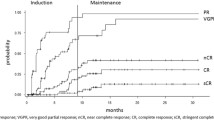Abstract
Nine patients with poor-prognosis, alkylator-refractory stage III multiple myeloma (MM) were treated with a 23-h continuous infusion (CI) of a compatible mixture of vincristine (VCR) and epirubicin (EPI) daily for 4 days along with a daily 1-h infusion of high-dose methyl prednisolone (MP) to total of 5 days (VEMP); cycles were repeated every 2 weeks when possible, usually on an outpatient basis. WHO grade 3 or 4 neutropenia and infection were the predominant toxicities encountered, necessitating some treatment delays and dose reductions. Two patients died during treatment. Peripheral neuropathy necessitated discontinuation of the VCR in six patients without obvious loss of efficacy of the regimen. Skeletal muscle dysfunction and cardiomyopathy did not occur; trivial ECG abnormalities occurred during a minority of infusions but were of indeterminate relationship to the chemotherapy. Confusion occurred in two patients; alopecia was frequent but reversible, and mild/moderate dyspepsia and stomatitis were common but easily managed. Eight patients achieved a partial response (PR); another patient experienced early death during his second cycle before response assessment. The median survival from the first VEMP administration was 9 months (range, 1–64+months), the median response duration was 7 months (range, 1–64+months). Two patients experienced responses too short to be clinically relevant (≤2 months). An analysis of weekly paraprotein estimations suggests that the intended bi-weekly cycle length may be optimal. Six of these nine patients derived major benefit from this bi-weekly regimen, which deserves further exploration.
Similar content being viewed by others
Abbreviations
- VEMP:
-
Vincristine, epirubicin and methylprednisolone
- MM:
-
multiple myeloma
- PR:
-
partial response
- VAMP:
-
vincristine, Adriamycin and methylprednisolone
- CR:
-
complete response
- PD:
-
progressive disease
- MTD:
-
maximally tolerated dose
- VCR:
-
vincristine
- EPI:
-
epirubicin
- LVEF:
-
left ventricular ejection fraction as determined by multiple ECG-gated radionuclide cineangiocardiography
- MP:
-
methylprednisone
References
Alberts DS, Salmon E (1975) Adriamycin (NSC-123127) in the treatment of alkylator-resistant multiple myeloma: a phase II study. Cancer Chemother Rep 59: 345
Alexanian R, barlogie B, Dixon D (1986) High-dose glucocorticoid treatment of resistant myeloma. Ann Intern Med 105: 8
Barlogie B, Smith L, Alexanian R (1984) Effective treatment of advanced multiple myeloma refractory to alkylating agents. N Engl J Med 310: 1353
Buzaid A, Durie BGM (1985) Management of refractory myeloma: a review. J Clin Oncol 6: 889
Case DC Jr, Ervin TJ, Gams R, et al (1988) Phase I–II study of epirubicin in multiple myeloma. Cancer Res 48: 6246
Cersosimo RJ, Hong WK (1986) Epirubicin: a review of the pharmacology, clinical activity and adverse effects of an Adriamycin analogue. J Clin Oncol 45: 425
Forgeson G, Selby P, Lakhani S, et al (1988) Infused vincristine and adriamycin with high dose methylprednisolone (VAMP) in advanced previously treated multiple myeloma patients. Br J Cancer 58: 469
Gomez GA, Han T, Ozer H, et al (1985) Salvage treatment for patients with multiple myeloma refractory to alkylating agents. Med Pediatr Oncol 13: 325
Gore ME, Viner C, Meldrum M, et al (1989) Intensive treatment of multiple myeloma and criteria for complete remission. Lancet II: 879
Jackson DV, Case LD, Pope EK, et al (1985) Single agent vincristine by infusion in refractory multiple myeloma. J Clin Oncol 3: 1508
Jain KK, Casper ES, Geller NL, et al (1985) A prospective randomized comparison of epirubicin and doxorubicin in patients with advanced breast cancer. J Clin Oncol 3: 818
Kyle RA, Greipp PR, Gertz MA (1986) Treatment of refractory multiple myeloma and considerations for future therapy. Semin Oncol 13: 326
Praga C (1991) Anthracycline induced cardiotoxicity and its relevance in cancer treatment. In: Nimmo WS, Tucker GT (eds) Clinical measurement in drug evaluation. Wolf, London, p 131
Samson D, Gaminara E, Newland A, et al (1989) Infusion of vincristine and doxorubicin with oral dexamethasone as first-line therapy for multiple myeloma. Lancet II: 882
Torti FM, Bristow MR, Howes AE, et al (1984) Preliminary observations of the cardiotoxicity of 4′-epidoxorubicin: an evaluation of endomyocardial biopsy. Proc Am Assoc Cancer Res 25: 179
WHO (1979) Handbook for reporting results of cancer treatment. Offset publication 48. WHO, Geneva
Author information
Authors and Affiliations
Rights and permissions
About this article
Cite this article
Vincent, M., Goss, G., Sinoff, C. et al. Bi-weekly vincristine, epirubicin and methylprednisolone in alkylator-refractory multiple myeloma. Cancer Chemother. Pharmacol. 34, 356–360 (1994). https://doi.org/10.1007/BF00686045
Received:
Accepted:
Issue Date:
DOI: https://doi.org/10.1007/BF00686045




